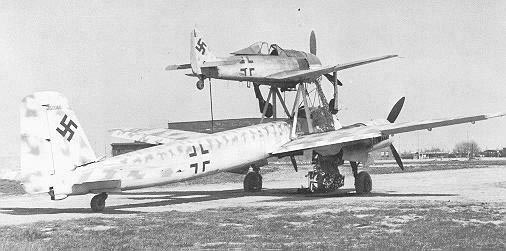Mistel Composite Aircraft

Description:
The Mistel series of composite aircraft are without a doubt one of the strangest concepts to achieve operational status with the Luftwaffe. The original concept was proposed to the RLM in 1941 by Siegfried Holzbauer, A Junkers test pilot. His idea was to make use of "tired" Ju 88 airframes by packing them with explosives, fly them near a target and crash them into the target after the fighter had released itself. The fighter pilot would control the "missle" after release by remote control. The first conversion flew in July 1943 and proved successful enough for the RLM to approved a further 15 conversions, with the code name Beethoven. Tests with Ju 88 fuselage sized hollow charge warheads against the French battleship Oran proved to be successful and an eventual thickness of 60 feet of reinforced concrete was breached in further tests. Over 250 Mistels of various combinations were built, but like all the Third Reichs super weapons, they proved too little too late. Warhead: - Source: Wikipedia
The definitive Mistel warhead was a shaped charge around a core of copper or aluminium. When detonated, the explosion would create a penetrator made of the core of the above-mentioned copper or aluminium. The metal would then "behave" like a liquid (and not, as often falsely reported, liquefy), capable of penetrating up to 7 metres (24 feet) of steel armour. It was anticipated that this would be able to "drill" straight through an enemy warship. Some 250 Mistels of various combinations were built during the war, but met with limited success. They were first flown in combat against the Allied invasion fleet during Battle of Normandy, targeting the British-held harbour at Courseulles-sur-Mer. While Mistel pilots claimed hits, none of these can be correlated in Allied records, and they may have been made against the hulk of the old French battleship Courbet, which had been included as a component of the Mulberry harbour at Arromanches and specially dressed up as a decoy by the Allies. Serious blast and shrapnel damage from a near miss was also suffered by HMS Nith, a floating headquarters, on 21 June. There were 9 killed and 26 wounded and the Nith was towed to back to England for repairs. A second opportunity to use the Mistels, in Scapa Flow in 1944 was abandoned after the loss of the Tirpitz assured local air superiority for the Royal Navy's aircraft carriers. As part of Operation Iron Hammer in late 1943 and early 1944, Mistels were selected to carry out key raids against Soviet weapons manufacturing facilities -- specifically, electricity-generating plants around Moscow and Gorky. These plants were known to be poorly-defended by the Soviets and irreplaceable. However, before the plan could be implemented, the Red Army was already pushing into Germany itself and it was decided to use the Mistels against their bridgehead at Kuestrin instead. On April 12, 1945, Mistels attacked the bridges being built there, but the damage caused was negligible and delayed the Soviet forces for only a day or two. Subsequent Mistel attacks on other bridges being thrown across the Oder were similarly ineffective.
Variants:
Mistel Prototype - Ju 88A-4 and Bf 109F-4
Mistel 1 - Ju 88A-4 and Bf 109F-4
Mistel S1 - Trainer version of Mistel 1
Mistel 2 - Ju 88G-l and Fw 190A-8 or F-8
Mistel S2 - Trainer version of Mistel 2
Mistel 3A - Ju 88A-4 and Fw 190A-8
Mistel S3A - Trainer version of Mistel 3A
Mistel 3B - Ju 88H-4 and Fw 190A-8
Mistel 3C - Ju 88G-10 and Fw 190F-8
Mistel Führungsmaschine - Ju 88 A-4/H-4 and Fw 190 A-8
Mistel 4 - Ju 287 and Me 262
Mistel 5 - Arado E.377A and He 162






